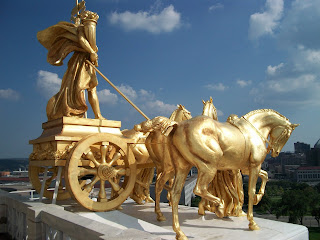
The building was designed by local Cass Gilbert, who went on to design other state capitols and such buildings as the United States Supreme Court building. He was not only the architect, but also had a main role in the interior art and decoration as well. Gilbert designed the building in the “Beaux-Arts” style that was popular at the time, and common among governmental buildings around the US. The Beaux-Arts style could be described as a more modern, American twist on classical European architecture. The building was completed in 1905, less than 50 years after Minnesota achieved statehood, and the goal was to build a capitol building that would showcase Minnesota's movement from a wilderness-filled territory to that of a civilized, sophisticated, important, and perhaps somewhat cosmopolitan locale. The fruit of that endeavor stands proudly before us, embodied in marble and granite.
Upon actually entering the capitol, one is drawn into the Rotunda in the center of the building. The floor of this circular area is inlaid with tile, glass, and brass, the latter used in a giant representation of the symbol of L'etoile du Nord, the North Star State.

This theme is repeated in decorative paint throughout the building.

Looking up, the Rotunda area soars above hundreds of feet to the inside of the dome. It is a space designed, it seems, to inspire awe and wonder, and to impress upon visitors the extensiveness of its beauty.
Wrought metal balconies look over the area from the second level, and four murals are found in panels on the inside of the dome.

These centrally placed murals by Edward Emerson Simmons depict the theme of “The Civilization of the Northwest,” with sub-themes such as wilderness, discovery, and agriculture. Having these themes presented in a classical way was purposeful, perhaps to frame the more recent history of the state in a classical and “civilized” context.
Honestly, the entire building is filled with art, murals, statues, quotes, and decorative elements, every piece conveying an idea or message of some kind. Almost every square inch is deliberately intended in a way, which is interesting to tour but can be overwhelming if you ruminate on it a bit too much
However, two styles of art are most prominent – realism and allegory. One of the best Realist pieces is found in the ornately decorated Governor's Reception Room, and is also a common sight for a lifelong resident of Minnesota, though I had never known the original was housed here.
It depicts Father Hennepin blessing the St. Anthony Falls, along with a group of Native Americans peacefully accompanying him. I've always liked the painting for the peace, harmony, and quiet it seems to depict among the two disparate peoples present, and also because I enjoy comparing that scene to the present site of the St. Anthony Falls.
Allegory is the other type of art found in the capitol. Though at times I find this style a bit heavy-handed, it can be great when it is done well. My favorite piece is one that (I have discovered) many people do not realize is allegory, but rather simply the main decorative piece of the capitol: The Quadriga.
Though the horses and chariot are common in classical art, the Quadriga at the capitol embodies some rather interesting imagery. The four horses depict the forces of nature, with the women holding their bridles depicting the forces of civilization that harness the forces of nature: agriculture and industry. The person on the chariot, holding a sign with the word “Minnesota” on it, is the progress of the state, pulled by these forces. I for one thought it was some really fun and well-done allegory, in a sensible way.
I would write more, but shouldn't. I instead leave you with these pictures:
-Catherine










No comments:
Post a Comment